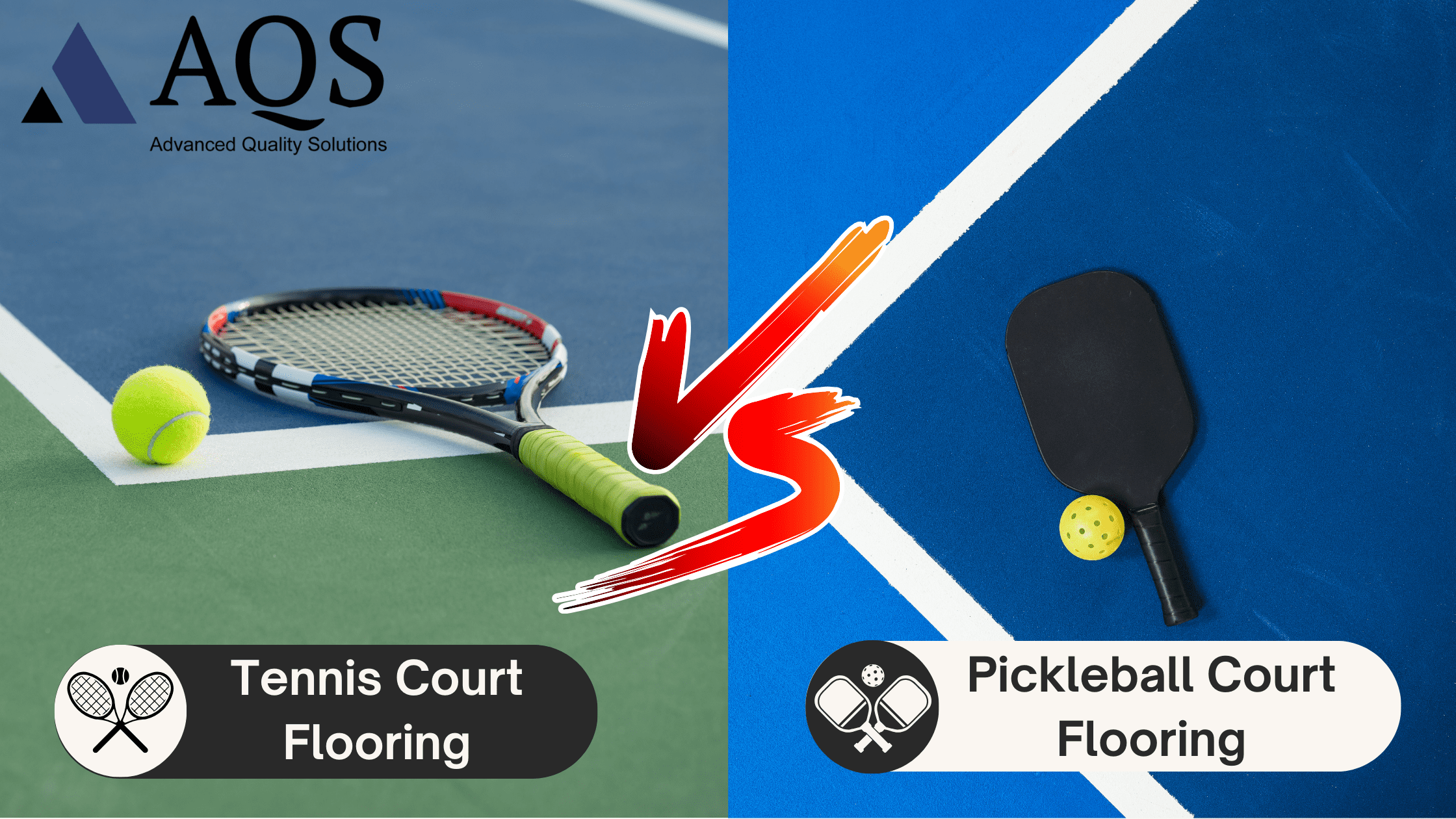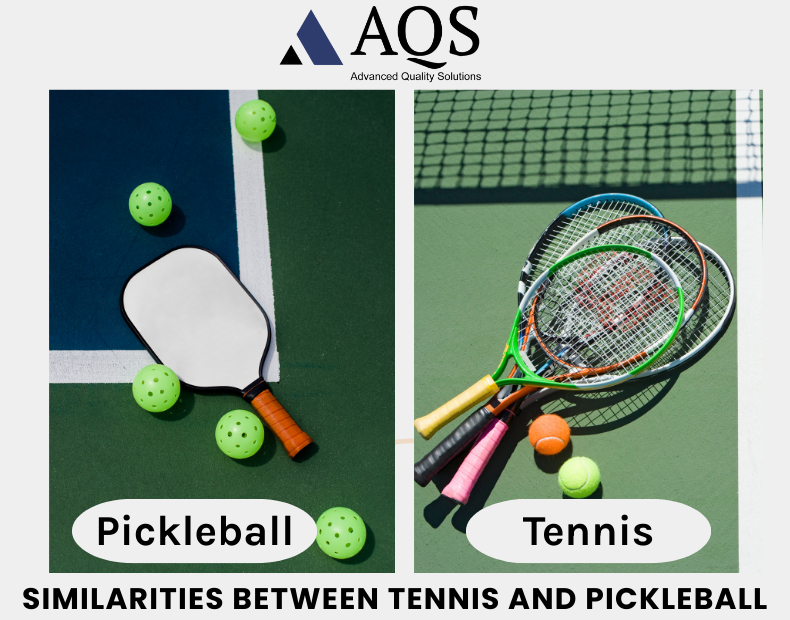
Pickleball is growing quickly in India and around the world. Players and facility managers often wonder: What’s the difference between a tennis court vs pickleball court? Both sports use nets, paddles, and courts. However, they differ in court size, flooring, equipment, and rules.
Knowing the differences is key, whether you want to build a new court or change an old one. In this post, we’ll compare pickleball and tennis court dimensions, conversions, rules, and costs.
What’s The Difference Between Tennis and Pickleball Courts?
The most obvious difference is size—a pickleball court size is much smaller than a tennis court size. There are other variations too. These include net height, flooring, equipment, and game rules.
Pickleball vs Tennis Court Dimensions
| Feature | Pickleball Court Size | Tennis Court Size |
| Length | 44 feet (13.41 meters) | 78 feet (23.77 meters) |
| Width | 20 feet (6.1 meters) | 27 feet for singles / 36 feet for doubles (8.23 / 10.97 meters) |
| Total Area (with clearance) | 30×60 feet (9.14×18.29 meters) | 60×120 feet (18.29×36.58 meters) |
| Net Height (Center) | 34 inches (0.86 meters) | 36 inches (0.91 meters) |
As you can see, a pickleball court size is one-fourth the space of a tennis court. You can fit several pickleball courts in one tennis court. That makes it space-efficient and cost-effective.
Can You Play Pickleball on a Tennis Court?
Yes, you can play pickleball on a tennis court! You can convert Communities, schools, and recreation centers’ tennis courts into pickleball courts. The sport is growing quickly.
To change a tennis court to a pickleball court, add temporary lines. You can use removable tape or chalk. Also, set up a portable pickleball net that is 34 inches high in the center. A pickleball court measures 44 feet by 20 feet. You can fit up to 4 pickleball courts on one tennis court. It makes for efficient use of space and is excellent for places that want to offer sports. It’s also helpful in testing pickleball’s popularity before building permanent courts.
It is not recommended to play tennis on a pickleball court. A pickleball court is small, limiting space for tennis. Tennis needs more room for rallies, serves, and side-to-side movement. Tennis racquets and balls are made for bigger courts, making it difficult to play or play safely on a smaller pickleball court.
Similarities Between Tennis and Pickleball
Tennis and pickleball are both racquet sports. They have similarities, even with their differences in court size, surface, and equipment.
- Both sports use a net: The net spaces across the middle of tennis and pickleball courts. It divides the court and boosts strategy and skill in the game.
- Singles or doubles games: Pickleball and tennis can be played one-on-one or in pairs, making them suitable for different group sizes.
- Scoring objective: In tennis and pickleball, you score points by serving the ball to your opponent’s side of the court. The aim in both games is to defeat your opponent by getting the ball back.
- Scoring system: Tennis and pickleball have different scoring systems. In both games, you must win by a certain point difference or lead your opponent by a set number of points to win.
- Flooring compatibility: You can use acrylic synthetic flooring for pickleball and tennis courts. It’s durable, weather-resistant, and performs well outdoors.
In terms of flooring and construction, both courts benefit from synthetic acrylic flooring, which offers: Excellent weather resistance, Slip-resistant, Consistent bounce and ball control.

Rule Differences Between Tennis and Pickleball
While the two games may look similar, there are some key differences between Tennis and Pickleball in playing.
| Feature | Tennis | Pickleball |
| Serve | Overhand, powerful | Underhand, below the waist |
| Scoring | 15-30-40, win by 2 | First to 11, win by 2 |
| Ball | Felt tennis ball | Plastic ball with holes |
| Court Movement | Full-court, more running | Smaller court, quick reflexes |
| Net Play | Volleys allowed anywhere | “No volley zone” near the net |
These rules change how players compete and reduce injury risks. This makes pickleball easier for seniors and beginners.
Pickleball vs Tennis Court Construction Cost
While the two games may look similar, there are many difference between tennis court and pickleball court construction cost –
Pickleball Court Construction Cost:
- Smaller Court size = Lower Cost: 44 ft x 20 ft pickleball courts require less space than tennis courts.
- Less Materials: Less surface area means less fencing, lighting and flooring.
- Faster Installation: Pickleball courts are quick to install. It is perfect for schools, clubs, and communities seeking a cost-effective option.
- Minimal Disturbance: Lightweight construction causes less disruption to surrounding areas.
Tennis Court Construction Cost:
- Larger Court Size = Higher Cost: A standard tennis court measures 78 ft by 36 ft for doubles. That makes it nearly four times bigger than a pickleball court.
- More Materials: More acrylic flooring, nets, posts, fencing and lighting. Tennis courts take longer to build. Their size and complexity are the main reasons.
Acrylic synthetic flooring material is highly recommended for both court types. It’s weather-resistant and low maintenance. It’s perfect for outdoor use, especially in India’s climate. AQS Advantage: We offer affordable, durable acrylic synthetic flooring designed for pickleball.
Which Flooring Materials Are Best for Both Courts?
Whether you’re installing a pickleball or tennis court, the choice of flooring materials will affect
- Ball Bounce: The surface affects the speed and bounce of the ball. Acrylic synthetic flooring ensures consistent and accurate ball response for better gameplay.
- Player Safety: A safe surface reduces the risk of slips and injuries. Our non-slip texture provides traction for agile, confident movement.
- Low Maintenance: Poor-quality flooring can lead to frequent repairs. AQS flooring is durable and low-maintenance, making it a smart investment.
- Weather Durability: Courts in India face intense sun, rain, and temperature swings. Our flooring is UV resistant and weatherproof, ideal for outdoor use.
At AQS, we provide acrylic synthetic flooring that is
- Weather resistant: It resists sun damage, rain, and temperature changes. That makes it perfect for outdoor use in any weather.
- Non-slip surface: Offers excellent grip to cut down on slips and injuries. It’s perfect for kids, adults, and athletes.
- Cost-effective: A strong surface needs fewer repairs and resurfacing. It saves money in the long run and ensures reliable performance.
- Available in many colors: Pick from a range of long-lasting hues to suit your court’s style, brand, or theme.
- Perfect for pickleball and tennis courts: It offers optimal bounce, safety, and playability. This flooring is a high-performance and versatile choice for both sports.
Conclusion
If you manage a facility, run a school, or love sports, knowing the difference between pickleball and tennis courts is important. This knowledge helps you make a smart investment. Pickleball courts are smaller than tennis courts. It means each sport suits different age groups, budgets, and space needs.
Pickleball court sizes are small and easy to build. They are affordable and open to players of all levels. Tennis courts suit anyone seeking a classic, high-energy racquet sport. No matter which court you pick, the quality of flooring matters. It affects performance, safety, and how long it lasts.
At AQS, we focus on high-quality acrylic synthetic flooring. It’s perfect for pickleball and tennis courts. Our surfaces are weatherproof and durable. They also boost player safety and make courts look better. Ready to build a high-performance sports court? Our team will help you every step of the way. We’ll cover design, materials, installation, and long-term maintenance.
Frequently Asked Questions
A pickleball court Size is 44 ft x 20 ft and a tennis court Size is 78 ft x 27 ft for singles. Net height and rules also vary.
Yes! Many people use tennis courts for pickleball by marking temporary lines and setting up a portable net. Up to 4 pickleball courts can fit inside one tennis court.
Pickleball court flooring are less expensive to build because of their smaller size and quicker installation. Tennis courts require more materials and space, so they’re more expensive.
Up to 4 pickleball courts can fit inside one standard tennis court.
Pickleball is easier on the joints because of its smaller court and slower pace, so it’s better for seniors and beginners.



